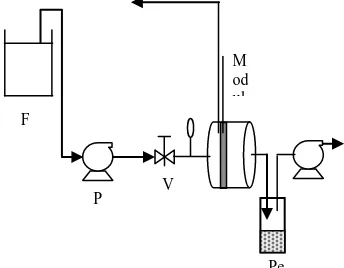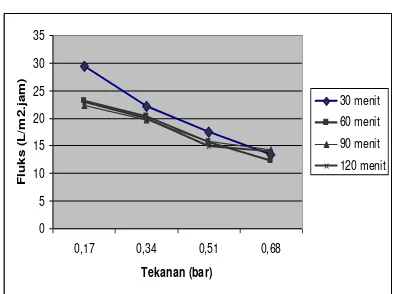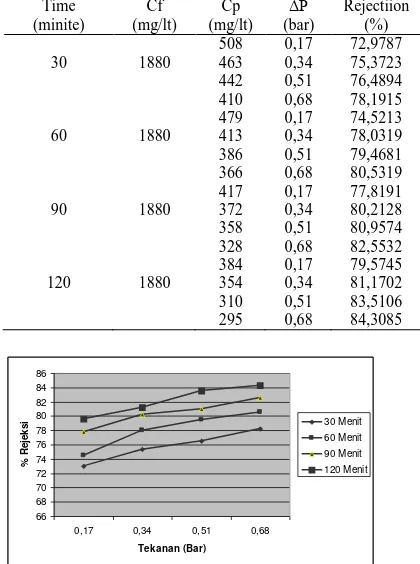LUBRICATING OIL WASTE PURIFICATION
WITH ULTRAFILTRATION MEMBRANE
Sri Redjeki
Jurusan Teknik Kimia, Fakultas Teknologi Industri UPN Veteran Jawa Timur Jl. Raya Rungkut Madya , Surabaya
email : [email protected]
ABSTRACT
This research used ultrafiltration membrane modules in the separation process of Total Suspended Solid (TSS) from lubricating oil waste. Ultrafiltration was a process to separate or concentrate a solution containing colloidal, materials with high molecular weight, with membrane. After the initial treatment of lubricating oil purification with ultrafiltration process, it a ppears that there was a decrease of TSS levels in permeate up to 295 mg/liter, compared to the levels of initial TSS material which is 1880 mg/liter. The analysis result of flashpoint parameter, water content and the sulfur content shows a value that has met standard specifications of fuel oil while the viscosity values was not meet the standard. Increasing the operating pressure will decrease the flux, as well as with increasing time will also reduce the value of flux until a certain time point. While the increase of % rejection occurs with the increasing pressure and operation time. The best condition that can be achieved in the purification of used oil with ultrafiltration process is by using a Cellulose Acetate membrane (pore diameter 0,48 m) which was operating at a pressure of 0,68 bar with the operating time of 120 minutes with TSS content of 295 mg/l and 84,3085% rejection. Results of the study indicated that the ultrafiltration membrane can be used in the purification of used oil and the outgoing permeate can be used as fuel oil.
Key words: ultrafiltration membrane, TSS, lubricating oil, cellluse acetate, fuel oil
INTRODUCTION
Lubricating oil is one of the petroleum products that still contain aromatic compounds with low vikositas index. Almost all machines use oil lubricants ascertained. Function is to provide a layer of lubricant between two surfaces that rub against the engine so as to prevent such contact. As the name implies, has the main task of lubricating oil lubricates the engine parts that come into contact or move against one another, thus avoiding the occurrence of wear and tear / rust on the machine.
The remaining used oil for this (Triono, 2007) nationwide reach 1.42 million liters per day. The price is also very cheap, only Rp 1,000 per liter, even some car or motorcycle repair shop getting used oil without buying, because the voluntary used oil that is changed from a motorcycle or a car, never refunded. Common use of used oil has been limited to material that is used a mixture of kerosene fuel boiler, or used
directly for burning limestone (lime), the most widely recycled into new oil and oil-base material (lube base oil) after going through several processes length with the addition of certain ingredients.
Nowadays, it has a lot of research on recycling of used oil in chemical process and the results are also quite satisfactory. For example, Oil Lubricant Base Oil Used to be using natural rocks as an absorbent, resulting in a base oil with kinematic vikositas 183.53 at 40 º C and 17.95 at 100 º C, flash point is 255.5, and specific gravity 0.892 with The best condition at the time of the process for one hour and the addition of clay as much as 30% (Wikipedia, 2001).
liquid sulfuric acid, and added Acid Clay (Three Ethyl Amin). After a while, used oil is deposited. A clear oil that is used to fuel burners (burners), specifically the work of researchers. Used oil is pumped by the blower for heating fuel, and it produces 1400 º C. The maximum heat When used to smelt aluminum only takes 0.1 liters of used oil, and dissolved in 8 minutes. For 2 pounds of cast iron need 2 liters of used oil and the time was 2-3 hours. Results were very good, considering the initial purification process of the used oil to use for fuel, does not require a long process. Only burners are used to type special
indeed. The various considerations above
ultimately lead to new alternatives in the processing of used oil that is by membrane technology.
Ultrafiltration is a process for separating or concentrating a solution containing a colloid, a material with high heavy molekul, until the suspended solids.
METHODOLOGY
Material
The materials used in this research is used lubricating oil waste as a feed solution and distilled water as test the stability of membranes
and membrane cellulosa acetate.
The research was conducted by using the set of ultrafiltration equipment. This system consists of a membrane module plate and frame ultrafiltration, valve,pump, membranes (Cellulosa acetate, pore diameter of 0.48 mm pump, units of pressure gauges, as well as other tools, such as: stop watch, measuring cup, erlenmeyer, and the beaker glass.
Variable Set
1. Membrane type: Plate and frame 2. Membrane material: Cellulosa acetate 3. Number of membranes: 1 Fruit 4. Volume of feed: 500 ml
Variable
1. Operating pressure (ΔP): 0.17; 0.34; 0.51
; 0.68 (bar) 2. Operating time: 30, 60, 90, 120 (Minutes) Characteristics of Ultrafiltration Membranes. Type: Ultrafiltration
Thickness: 150 μm (for a few monolithic ceramic)
Pore size: 100-100 nm
Driving style: Pressure (1-10 bar)
Principle of separation: Mechanisms filtering Membrane materials: Polymers, ceramics
Figure 1. Process Instrument
The composition of the equipment as shown, feed solution used lubricating oil waste with a volume of 500 ml incorporated in the feed tank, then flows into the membrane module by using a pump with a predetermined pressure. The system is operated 0.5 hours to stabilize the process
analyzed according to the variables of the run, while the retentate accommodated. Repeated in the same way to pressure, and membranes and different operating times.
RESULTS AND DISCUSSION
Ultrafiltration is a process for separating or concentrating a solution containing colloids, high molecular weight material, until the suspended solids. The use of cellulose acetate membrane with the composition of CA-13 is the most suitable for the ultrafiltration process. Membrane operations conducted by CROs stream flow system, at a pressure of 2.5 to 3.5 kg/cm2. From the results of the study, water permeability of the membrane CA-13 reached 42.41 L/m2 hour bar. In testing using artificial wastewater with concentrations of 3% obtained flux between 40.66 to 72.73 L/m2 hours. In studies using waste oil emulsion PT. Indonesian aerospace flux obtained
F
P V
rejection total to 3% artificial waste reaches 92.89 to 95.86% and rejection for the waste oil emulsion PT. Indonesian aerospace ranged 95.53 to 96.65%. While the rejection of surfactant reaches 87.26%. The successful processing of used oil by using ultrafiltration membranes is expected to refine the method of recycling used oil is a chemical process so that later there is no waste is wasted. Besides the success of this research will also positively impact efforts to reduce levels of environmental pollution since the liquid waste used oil is very dangerous for the environment and categorized as B3 waste (hazardous and toxic materials). If the used oil can be recovered it will save the use of petroleum as a raw material for Institute for Research and Industrial Consultancy (BPKI) Surabaya - East Java are as follows:
Table 1. Analysis Data Lubricating oil waste
No Parameter Unity Analysis Results
Feed Permeate Viscosity at 100°C Flash point C.O.C
Figure 3. Fluxs Vs Operation Pressure
From Figure 3 can be seen that the higher the operating pressure the value of the flux will decrease. This is due to the high operating pressure, permeate volume produced is also getting smaller so that the flux values are also lower. This is consistent with the permeability equation in which value is proportional to the volume permeate flux. From the table above also found that the flux is highest at 30 minutes of operating time and operating pressure of 0.17 bar. While the lowest value of the operating time of 60 minutes and the operating pressure 0.68 bar.
Table 3. % Rejection
Figure 4. % Rejection Vs Pressure
From Figure 4, can be seen that the higher pressures and time of operation, the greater the% rejection membranes. This is influenced by the concentration of permeate are getting smaller because of the amount of TSS in the permeate getting smaller too. So that the calculations and the results of tables and graphs above shows the conformity with the equation% rejection, where the value of % rejection is inversely proportional to the concentration of permeate. From the picture above can also be seen that the highest value of% rejection at the operating pressure of 0.68 bar and the operating time of 120 minutes, this happens because the small permeate concentration. While the lowest value that is at a pressure of 0.17 bar operations and operating time 30 minutes, this is caused by a large concentration of permeate. From the table of analysis results in Table 3 we can see that there is a decrease in permeate TSS levels when compared with the early
be used to reduce levels of TSS in the used oil. At the other parameters such dianalisakan flash point, water content and sulfur content showed values that have met the standard specifications Fuel Oil. As for the viscosity parameter, its value has not meet the standard specifications Fuel Oil. This probably occurred because the operation and condition of the tool used less than optimal. However, based on the overall results of analysis of various parameters, used oil produced from the refining process with ultrafiltration membrane can
be used as fuel oil.
CONCLUSION
From the research data obtained from the "Used lubricating Oil waste Purification By Ultrafiltration Membrane" shows that:
The data analysis of research results obtained, it can be seen that a decline in levels of TSS in TSS levels permeate compared early material, this means that the ultrafiltration membranes can be used in refining used lubricating oil wsate. In the results of analysis flash point, water content and process with ultrafiltration membrane can be used as fuel oil. Increasing the operating pressure will result in decreased flux, as well as with time will also reduce the value of flux until at a certain time. Increased% rejection occurs with increasing pressure and operating time. The best conditions that can be achieved in the process of refining used oil by ultrafiltration using Cellulosa acetate
REFERENCES
Baker,R.W, Cussler, E.L, Eikamp, W, Koros, W.J, Riley, R.L, Strathmenn, H, 1991,
”Membrane Sparation Sys-tem”. Neyes
Data Corporation, Park Rigde, New Jersey, USA.
Cheryan, Munir.1956. “Ultrafiltration Hand
-book”, Technomic Publishing Co-.Inc.
Lancaster Basel.
Hartomo, Widiatmoko, 1992, ”Teknologi
Membran Pemurnian Air” Andi Offset,
Yogyakarta.
Layanan Teknis Pelumas, 2004, ”Cara Smart Memahami Pelumas”, Edisi Maret,
Pertamina, Jakarta.
Mulder, M, 1990, “Basic Principles of Mem-brane
Technology”, Kluwer Aca-demic
Publisher, London.
Mulder, Marcel, 1996, ”Basic principle of
membrane technologi”, Klower Aca
-demic Publisher.
Nelson,W.L, 1985, ”Petrolium Refinery
Engginering”, Fourth Edition, Mc
Grow-Hill Book Company, New york.
Nieman, G. 1994, ”Elemen mesin”, Erlangga,
Jakarta.
Peraturan Pemerintah No:83 Tahun 1999.
Redjeki,Sri. 2005, “Operasi Teknik Kimia III”,
Diktat, Universitas Pembangunan
Nasional “Veteran” Jawa Timur.
Triono, Joko. 2007, ”UNS Kembangkan Ba-han
Bakar Dengan Oli Bekas”, Per-pustakaan
Departemen Teknik Lingkungan,
Bandung.
Wenten, I.G., 2001, “Teknologi Membran Industrial”, Bandung.
www.google\Ultrafiltrasi\www.wikipedia.com.org \2001


